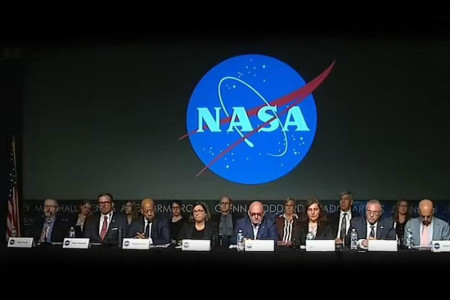The landmark report, which covered hundreds of cases of unidentified objects or phenomena in our skies, was published today after being commissioned by the space agency last year.
The 16-expert advisory panel stressed that there is 'no reason to conclude' that any of the sightings have been alien in origin - however, the panel did warn that mysterious flying objects were a 'self-evident' threat to American airspace.
Even though they poured cold water on the extraterrestrial (ET) hypothesis, NASA's experts did not deny the possibility of a 'potential unknown alien technology operating in Earth's atmosphere.'
Their 33-page report called for NASA to utilize its technological might to continue studying UFOs because many cases remain unsolved - and researchers still have no idea what some of these sightings are.
NASA chief Bill Nelson announced that a new director for UFO research would help the space agency implement the panel's recommendations.
But the person now in that role, who is already hard at work, was not named publicly due to threats made online.
The NASA advisory panel's unprecedented new report, which comes as UFO fever has reached a tipping point in the US, analyzed more than 800 cases across three decades - albeit with a budget of just $100,000 and only about nine months to conduct their work.
The panel noted that, to date, most UFO sightings are recorded with sensors and other equipment intended for nonscientific purposes, under accidental or 'serendipitous' circumstances that are far from ideal.
Evidence from nearly all UFO cases, in other words, was not collected with enough scientific rigor for experts to reach reliable conclusions in the panel's view.
'Coupled with incomplete data archiving and curation,' the NASA panel wrote, 'this means that the origin of numerous UAP [UFOs] remain uncertain.'
NASA's panel of 16 experts, however, had not been assembled to ascertain the whole truth about every UFO case in less than a year's time.
The advisory panel was primarily tasked with the goal of recommending new investigative avenues for future UFO research — advising on how best the US space agency's own tools could aid in the search for ET visitation.
NASA announced last year that it would review evidence regarding unidentified anomalous phenomena (UAPs), more commonly known as unidentified flying objects (UFOs).
For the purposes of their study, the panel defined UAP as sightings 'that cannot be identified as aircraft or known natural phenomena from a scientific perspective.'
In their final report issued today, the NASA team elaborated that, in their scientific view, the bar for proof of extraterrestrial visitors to our planet must be kept high.
'In the search for life beyond Earth, extraterrestrial life itself must be the hypothesis of last resort,' the panel wrote, 'the answer we turn to only after ruling out all other possibilities.'
'As Sherlock Holmes said, 'Once you eliminate the impossible, whatever remains, no matter how improbable, must be the truth.''
During the question and answer session that followed the release of their report, the head of NASA's UAP advisory panel, astrophysicist David Spergel cautioned that more work will be needed to collect data on UAP, a process which he said has been marred by 'a limited sample of events' and 'limited data.'
'Stigma has limited reporting by pilots, both civilian and military,' Spergel noted. 'So we know there's missing data.'
Back in May, NASA's independent study team shared their preliminary observations — that up to 98 per cent of reported UAP sightings can be explained away.
Just 2 to 5 percent are considered 'possibly really anomalous', the panel added, but a lack of high-quality data is hampering researchers' ability to apply 'rigorous scientific scrutiny' to the mystery-solving.
These genuinely unexplained UAPs are defined as 'anything that is not readily understandable by the operator or the sensor,' or 'something that is doing something weird,' said team member Nadia Drake earlier this year.
NASA's panel leader David Spergel echoed those comments today - adding 'even if there are some events that, in the end, turn out to be something novel, most events are going to turn out to be conventional things: balloons, airplanes, and so on.'
DM


